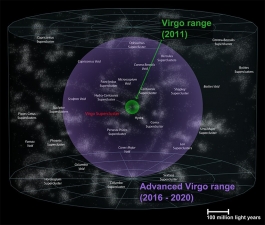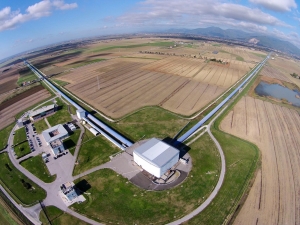Advanced Virgo is ready
21-02-2017

Advanced Virgo will be able to detect gravitational waves arriving to Earth from 10 times larger distances i.e. from 1000 times larger space than before (illustration: Virgo Collaboration, http://public.virgo-gw.eu)
Objective of the Advanced Virgo project officially concluded on February 20, 2017 in European Gravitational Observatory (EGO) in Pisa (Italy) was to modernise the Virgo interferometer. Polish scientists participated in the project. It is hoped that the Advanced Virgo detector will significantly advance research on gravitational waves, so far the largest discovery in physics of the 21st century.
The project run by scientists from six European nations (including Poland) associated in Virgo Collaboration lasted for more than five years. The upgrade of the Virgo detector (constructed in 1994) consisted in replacement of optics with heavier and better mirrors, new and more powerful electronics, extra seismic isolation systems, scattered light buffers, and some vacuum system improvements. In result sensitivity of the detector has been improved more than 10 times, which translates into capacity to search for sources of gravitational waves in some 1000 times larger space in the Universe than before.
Conclusion of the Advanced Virgo project marks a true milestone in research on gravitational waves. We hope that experimental data on the waves acquired in the future by both our modernised detector and the US-located interferometers will greatly help us to verify the existing theories – explains Professor Andrzej Królak from the Polish Academy of Sciences Mathematics Institute and NCBJ, leader of the POLGRAW team of Polish scientists participating in the Advanced Virgo project – The new detectors should allow us not only to much more accurately locate in the Universe sources of the waves, but also to identify cases, in which the waves had been emitted by rotating neutron stars or explosions of supernovae.
Each of the two perpendicular arms of the Advanced Virgo interferometer is 3 km long. The arms make possible to compare two reflections of the same laser beam travelling along two perpendicular paths. Comparison accuracy may reach a few thousandths parts of a proton diameter (10-18 metres). Even such a tiny difference may indicate that time-space was temporarily distorted, perhaps because of some traversing gravitational waves. The task to knowledgeably separate such signals from the background is a key challenge of the project. POLGRAW scientists have been mostly involved in just such issues. Construction of some components of the Advanced Virgo detector was another in-kind contribution of Poland to the project.
The POLGRAW team members include researchers from Polish Academy of Sciences Mathematics Institute and Nicolas Copernicus Astronomy Centre, NCBJ, Universities in Bialystok, Torun, Cracow, Warsaw, Wroclaw and Zielona Gora. They developed background for numerous algorithms and methods useful to detect and estimate parameters of gravitational waves emitted by double systems (Professors Andrzej Królak and Piotr Jaranowski), contributed to development of a precise method of modelling of such waves (Professors Piotr Jaranowski and Andrzej Królak), made simulations showing that double systems of black holes are the best candidates for detection of sources of gravitational waves by the LIGO-Virgo detector (Professor Tomasz Bulik), studied astrophysical properties of double systems (D.Sc.Michał Bejger, Dr.Izabela Kowalska-Leszczyńska, D.Sc.Dorota Rosińska), and looked for optical bursts that might accompany emission of gravitational waves (Dr.Adam Zadrożny).
Gravitational waves were first detected on Earth on September 14, 2015. They were produced in an event of collision of a black hole of a mass of 29 Suns with a black hole of a mass of 36 Suns. The produced black hole had a mass of 62 Suns, the balance (3 Sun masses) was emitted in the form of gravitational waves. That breakthrough discovery was made in USA using the Advanced LIGO facility composed of two interferometers located 3 thousand kilometres away (in Washington and in Louisiana). Both detectors have logged the signal almost simultaneously.
Humanity has waited for experimental discovery of gravitational waves more than 100 years since publication of Albert Einstein’s General Theory of Relativity in 1916. A suggestion that gravitational forces are just a visible effect of a curvature of space caused by masses located within that space was at the heart of that theory. Some calculations made according to the theory showed that some events might produce gravitational waves propagating through the space-time.





